Focusing on STEAM to Support Innovation and Creativity
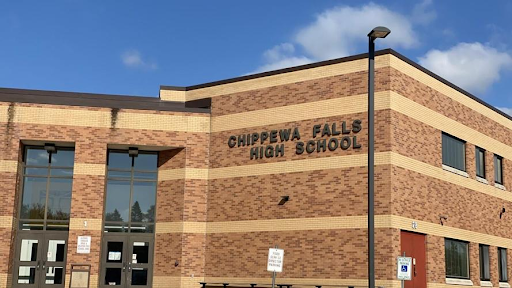 Chippewa Falls High School (Chi-Hi) is located in Chippewa Falls, a suburb of Eau Claire in Northwest Wisconsin. In 2022, it had 1458 students, with 91% White, 2.5% Hispanic, 1.6% Black, 1.4% Asian, 0.4% American Indian, and 3% two+ races. Additionally, 33.2% of students were labeled as economically disadvantaged.
Chippewa Falls High School (Chi-Hi) is located in Chippewa Falls, a suburb of Eau Claire in Northwest Wisconsin. In 2022, it had 1458 students, with 91% White, 2.5% Hispanic, 1.6% Black, 1.4% Asian, 0.4% American Indian, and 3% two+ races. Additionally, 33.2% of students were labeled as economically disadvantaged.
In 2021, Dr. Kevin Anderson had the privilege of interviewing several members of their STEAM Dream Team, including teachers and administrators. This profile is an amalgamation of their responses, edited for clarity.
School Profile Contents
What is our vision for this STEM work? What is our “why” for doing this work?
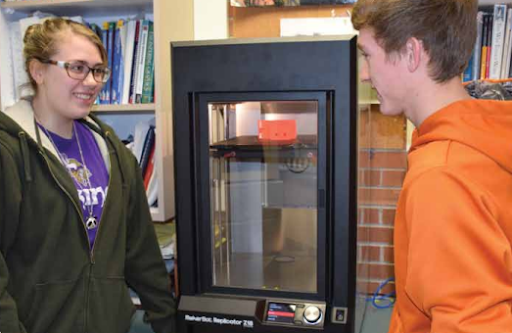 The mission of the Chippewa Falls High School STEAM DREAM Team is “to inspire student, teacher and community appreciation and excitement for STEAM education by engaging students in hands-on, real-world applications to increase success and achievement in school, opportunities for post-secondary education and careers.”
The mission of the Chippewa Falls High School STEAM DREAM Team is “to inspire student, teacher and community appreciation and excitement for STEAM education by engaging students in hands-on, real-world applications to increase success and achievement in school, opportunities for post-secondary education and careers.”
We focused on STEAM in particular to support innovation and creativity. We see that happen in ideation and the design process in the art department, which highlights that A for art in STEAM. We wanted to cast a wide net to engulf and engage all of our students, where students see connections in the breadth of ideas and creation rather than a more narrow focus on STEM. The creativity side is so important in science, math, and engineering. For example, it’s the tech innovators that get us places. We had board and community input into this process as well, with support for integrating the arts.
What does STEM/STEAM look like?
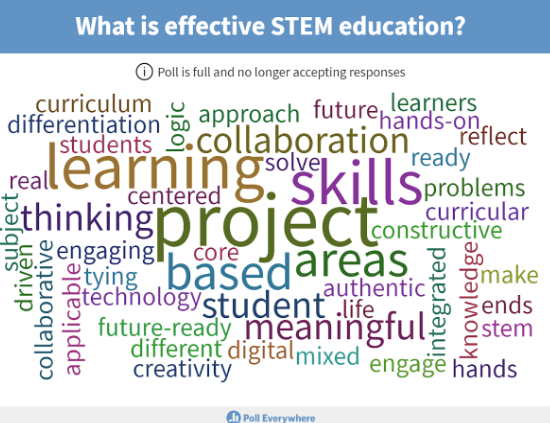 At the core of our STEAM initiative was a community referendum to fund a Fab Lab. As noted on our website, “The Chippewa Falls Area Unified School District Fab Lab, located within the Chippewa Falls Senior High School, was designed and built to promote STEAM (Science, Technology, Engineering, Arts, and Mathematics) education for the students and community members within the district.” This Fab Lab allows for cross-disciplinary projects that truly connect to who students are. As noted in our staff survey on effective STEM education (see the word cloud image), we see STEAM as being project-based, student-centered, authentic, and collaborative, with a focus on future-ready skills.
At the core of our STEAM initiative was a community referendum to fund a Fab Lab. As noted on our website, “The Chippewa Falls Area Unified School District Fab Lab, located within the Chippewa Falls Senior High School, was designed and built to promote STEAM (Science, Technology, Engineering, Arts, and Mathematics) education for the students and community members within the district.” This Fab Lab allows for cross-disciplinary projects that truly connect to who students are. As noted in our staff survey on effective STEM education (see the word cloud image), we see STEAM as being project-based, student-centered, authentic, and collaborative, with a focus on future-ready skills.
A group of teachers had the idea of creating an interdisciplinary Fab Lab space to engage all students and bring in more of a creativity emphasis. We talked to administrators, who supported the idea, then spoke with the school board and held community meetings for input and buy-in. Our community voted to support the referendum!
Where is STEM/STEAM happening? What do school and schedule structures look like to make it work?
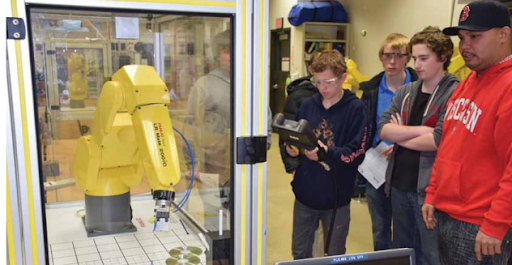 We are starting with a focus on inquiry across subject areas to gain momentum. We do not want chunks of S, T, E, and M, but instead a unified instructional approach, though we realize that STEAM with the A is not a common word and approach yet.
We are starting with a focus on inquiry across subject areas to gain momentum. We do not want chunks of S, T, E, and M, but instead a unified instructional approach, though we realize that STEAM with the A is not a common word and approach yet.
We are working to develop a coherent scope and sequence across K-12 yet. There is a lot of great inquiry and STEAM work happening in different classrooms and across subjects, but it’s not necessarily labeled as STEAM.
One way we are getting out this vision is through STEAM events. We hold an annual STEAM Night designed for the community and younger students. Middle school science teachers encourage their students to attend and share what they have been learning. That starts to reach younger students. Over 1000 people attend, but it’s only one night. We also had a district booth at the Northern Wisconsin State Fair with an emphasis on STEAM, further sharing our vision and growing support.
Robotics and our Green Team provide other examples of interdisciplinary student work. We have an after-school Voyagers Robotics Club. Community members have served as coaches. A two week summer robotics program is led by graduating students, a technology education teacher, and a community member. Our Green Team, on the other hand, is held as an independent study course. Students there even earned their drone pilot licenses and used thermal imaging technology to map district schools’ energy efficiency.
How is equity centered in this work? How are you supporting all students?
Equity encompasses a lot of aspects of our work. We have an equitable multi-level systems of support team. We are also looking at all of the features of an electronic Learning Management System (eLMS) to support students. This summer we will be doing an audit to review the effectiveness of our efforts, including looking at data to evaluate who does and does not have access to rigorous STEM programming. It is an ongoing challenge to move traditional education to more engaging, interdisciplinary learning for ALL students.
We want our Fab Lab area in particular to be accessible to all students. With our inclusion model, students receiving special education services access the Fab Lab along with their peers in regular classes. Further, we have students receiving special education services who work as interns in the Fab Lab. These students provide maintenance, upkeep, and peer support within that space. Fab Lab coordinators are full-time teachers and manage the FabLab, so having these interns eases their load and provides solid work experience. We want to continue to support more work-based learning for our students.
Females are clearly underrepresented in STEM fields. More enroll in our arts and design spaces, which is another reason for our STEAM emphasis. We were grateful to have a female middle school technology education teacher to be a role model in this space, though a male ChiHi graduate has now moved into that role (inspired by his Youth Apprenticeship experience while in high school!). We also offer students a summer “Step Up” program in physics, led by two female physics teachers.
The physical design of our Fab Lab, and the training offered on using it, makes it accessible to all teachers. We expect that increased teacher access will also make it more equitable and accessible for students. We want all students to have exposure to this unique space for creativity, inquiry, and creation. We consistently ask, “How are we breaking down these silos and helping kids see the connections among courses?” We also hope to have students engage in real community problems in this space, noting disparities in how some issues, such as pollution, affect some parts of the community more than others.
How are community and student voices involved? How are partnerships supporting this work?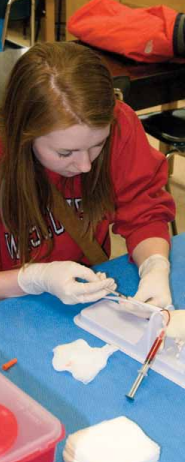
Our Fab Lab referendum started many conversations with the community. We are grateful that the community really chose this STEAM and FabLab space. Notably, one of our school board members is an architect and went to a conference and heard about STEM and STEAM. This board member came back and championed STEAM work in the district. Act 10 also sparked some conversations about how we as educators could more positively connect with the community, and create two-way support.
Our science open house gradually evolved to become our annual STEAM night in March. We asked community members to come in and share their STEM/STEAM related work, and about 30 businesses come and shared ideas on what you can do within a STEAM career. That has continued to develop into more collaborations and curriculum connections. Our Career and Technology team has particularly continued to build on connections with business partners.
What does professional learning look like?
While we initially had outside experts support training on the equipment in the STEAM lab space, a lot of our ongoing professional development has been done as we teach each other. For example, we have an annual “Cardinal Conference” where we share our expertise. Recently, we have had sessions there on the following topics: a 20% genius hour time within STEAM learning, modeling in the science classroom, and inquiry-based learning across the curriculum.
Funding, collaboration, and inclusion are three of our key challenges (though, as noted above, equitable access in STEAM for all students is an ongoing challenge too).
First, funding is a huge hurdle. We wonder how districts can find the funds to pay for ongoing training and professional development for all of their educators. We’re working on that.
Second, we have declining student enrollment, so staffing is inconsistent. That makes collaboration across STEAM subjects difficult. Furthermore, time for collaboration is a problem. Ideally, districts would have time for collaboration built into their schedules; however, we're lucky if we meet once a month for 30-45 min (as a department).
Finally, we see the need to build inclusion into STEAM, along ethnic, racial, and even transdisciplinary lines. Again, with losing positions, it is less feasible to provide extra student support, such as with co-teaching with special education teachers. We are trying to incorporate more cultural inclusion into our work and explore how to collect data to guide us. The reality is that we need outside help in this endeavor.
How will the STEM program be evaluated?
Our program is goal oriented, and we set three main goals for success within our Fab Lab program:
- Lab access - number of different students using it in a year;
- Number of content areas - monitor the cross curricular use;
- Community or district impact.
To support our work, we reached out to Jen Peck, STEM Specialist at CESA 10, who went through a process with the team-. That included cross-content teachers, CTE areas, ag, tech ed, and the arts. We went through the Carnegie STEM Excellence Pathway and did an evaluation of where we were at. Based on that initial evaluation, we then broke into sub-committees, looking at professional development, particularly our goals for it, access to it, and logistics for it. After that we met intermittently through the school year to review our work, noting slow progress due to all the logistical things to take care of.
Thinking of evaluation (or reflection) on our work, we thought the DPI STEM Self-Reflection Tool helped us think about our programs in new ways. It could be useful in our work to spend more time reflecting and less time on action plans. The DPI tool is more accessible and straightforward than the Carnegie process we went through with the CESA help. We could do this DPI-created review with our sixteen person team in one morning, whereas Carnegie was a multi-day process, and it is rare to be able to invest that amount of time.
It could be useful in our work to spend more time reflecting and less time on action plans. The DPI tool is more accessible and straightforward than the Carnegie process we went through with the CESA help. We could do this DPI-created review with our sixteen person team in one morning, whereas Carnegie was a multi-day process, and it is rare to be able to invest that amount of time.